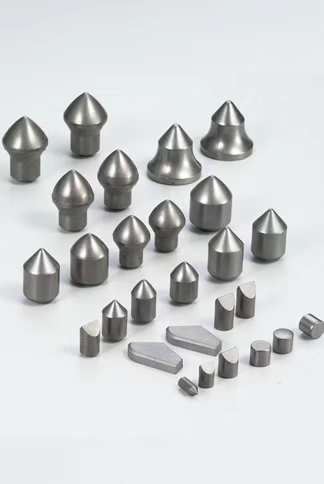15
2025
-
09
Sharp Rise in Raw Material Prices for Hard Alloys
Current Situation of Sharp Rise in Raw Material Prices for Hard Alloys
The hard alloy industry, crucial for sectors like advanced equipment manufacturing, aerospace, and electronics, is experiencing a significant surge in the prices of its key raw materials, primarily tungsten and cobalt.

Key Factors Driving the Price Surge
· Sharp Increase in Tungsten Concentrate Prices: The most significant driver is the substantial rise in tungsten concentrate prices. Reports indicate that from May to July 2025, the price of tungsten concentrate soared by 30-40%. Furthermore, data shows the price of Jiangxi standard ore (65% grade tungsten concentrate) skyrocketed from ¥141,500 per metric ton at the beginning of 2025 to ¥281,500 per metric ton by September 2025.
· Rising Cobalt Prices: The price of cobalt powder, another essential binder material in hard alloys, has also increased noticeably. Companies like Zhangyuan Tungsten have explicitly cited rising cobalt powder costs as a contributing factor to their production cost hikes and subsequent product price adjustments.
· Supply-Demand Imbalance: This price surge is attributed to a combination of:
· Tightened Supply: Stricter implementation of tungsten mining quotas and environmental policies in China (a major tungsten producer) have constrained supply. For instance, the first batch of national tungsten mining quotas in 2025 was reduced by 6.45% year-on-year. Additionally, declining ore grades and increasing mining difficulties have exacerbated supply constraints.
· Strong Demand: Demand remains robust from various sectors, including new energy (e.g., photovoltaic tungsten wire), high-end manufacturing, aerospace, and semiconductors. Geopolitical factors and increased global military spending are also contributing to demand, particularly for strategic stockpiling.
Impact on the Hard Alloy Industry
The rapid rise in raw material costs has created severe challenges for downstream hard alloy manufacturers:
· Severe Cost-Price Squeeze: A serious imbalance has emerged between soaring input costs and the slower adjustment of downstream product prices. The cost transmission mechanism along the supply chain is under strain. For example, the price of medium-particle tungsten carbide powder (WC) reached ¥625,000 per ton by the end of August 2025.
· Plunging Profitability: Many enterprises, especially Small and Medium-sized Enterprises (SMEs), are facing intense profit margin compression. Some report profit margins for certain cutting tool products falling below 10%. Some SMEs are even at risk of bankruptcy.
· Procurement Hesitation: The extreme market volatility and uncertainty have led to a cautious "wait-and-see" approach among downstream players, further affecting market dynamics.
Response and Coping Measures
Companies and industry bodies are adopting various strategies to mitigate the impact of these cost pressures.
1. Price Adjustment and Cost Management
· Product Price Increases: Hard alloy producers are inevitably passing on some of the cost increases to their customers. Numerous companies, including Zhangyuan Tungsten (starting April 1, 2025) and Luoyang Jinlu Hard Alloy Tools Co. (starting March 1, 2025), have officially announced price hikes for their hard alloy products.
· Inventory Management: Some companies try to build up raw material inventories during the early stages of a price increase to cushion the impact on future production costs.
· Operational Efficiency: Firms are focusing on optimizing procurement, strengthening production management, and conducting cost analyses to control and reduce overall expenses.
2. Technological Innovation and Product Upgrade
· Shift to High-Value-Added Products: Companies are increasingly focusing on developing and producing higher-margin, specialized products. For instance, CNTIC Advanced Materials Co. is expanding its range of high-value-added hard alloy products, such as nano-coated tool materials and new composite structural drilling tools, which offer better resistance to raw material price fluctuations and longer service life.
· Process Improvements: Technological innovations are being employed to enhance efficiency and reduce material consumption. This includes using intelligent batching systems to control raw material usage precisely and adopting new sintering technologies to improve product density and yield.
· Material Research: Developing new material grades and product designs (e.g., fine-grained or low-cobalt grades) to maintain performance while managing cost pressures.
3. Industry Advocacy and Collaboration
· Calls for Market Stability: Industry associations and groups of enterprises are calling for collective action. For example, hard alloy enterprises in Sichuan issued a joint initiative urging government departments and associations to strengthen market monitoring, prevent systemic risks, and curb speculative capital exacerbating price fluctuations.
· Emphasis on Fair Competition: The industry is advocating for a healthy competitive order, opposing any form of price manipulation or monopolistic practices, and promoting long-term stable partnerships between upstream and downstream players.
4. Diversification and Strategic Development
· Exploring New Markets: Companies are looking towards emerging markets, particularly under initiatives like the "Belt and Road," for new growth opportunities.
· Developing New Business Lines: Some companies are investing in adjacent growth areas to diversify revenue streams. For instance, Oke (Euro-KEY) established a joint venture to enter the photovoltaic tungsten wire market, seen as a promising future market.
· Global Expansion: Strengthening overseas channel construction and partnerships to tap into international demand growth, which is also driven by global industrial and military needs.
Outlook
In the short term, tungsten prices are expected to remain high or potentially increase further due to persistent supply tightness and solid demand. Over the long term, prices may stabilize and retreat as new resources are developed, technologies advance, and supply and demand find a new balance.
The ability to pass on costs varies significantly across market segments: it's generally easier in high-end sectors like aerospace, military, and premium cutting tools, where product value is high and customers are less price-sensitive. Conversely, it's much more challenging in price-sensitive, competitive markets for standard or low-end tools.
The current crisis is ultimately pushing the hard alloy industry towards consolidation, technological upgrading, and a stronger focus on high-value, innovative products.welcome to www.zzgloborx.com to communicate with each other.
RELATED NEWS
Zhuzhou Zhongge Cemented Carbide Co., Ltd.
AddNo. 1099, the Pearl River North Road, Tianyuan District, Zhuzhou, Hunan
SEND US MAIL
COPYRIGHT :Zhuzhou Zhongge Cemented Carbide Co., Ltd. Sitemap XML Privacy policy














